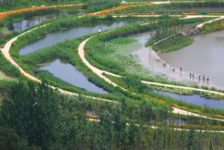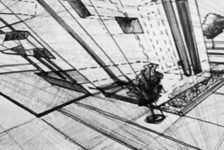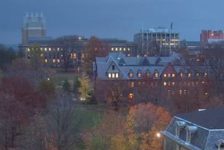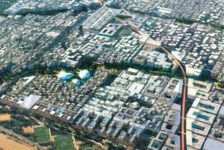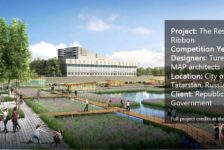15-September-2015 The Latest News in Landscape Architecture 2015 is sponsored by ZinCo – Life on Green Roofs – Ecological and Economical Green Roofs, worldwide. In this week’s Latest News in Landscape Architecture we feature an enormous green roof (which soon could be coming to Silicon Valley), explore Detroit’s Culture Lab Dialogue, and announce London’s underground hydroponic farm. Did you know that the leafy greens grown underneath the busy streets of Clapham in London could be in your kitchen within four hours of being picked and packed! 5 Stories In The News This Week:
- Genetic Engineering Turns A Common Plant into A Cancer Fighter
- An Underground WWII Bomb Shelter in London Has Been Converted into the Largest Subterranean Hydroponic Farm
- How Should We Design Cities to Make the Most of Urban Ecosystems?
- Rafael Viñoly To Build the World’s Largest Green Roof in Silicon Valley
- Culture Lab Detroit to Explore Greener Future for City
(Click the headline for the full story)
Latest News in Landscape Architecture
According to researchers, a common laboratory plant has been developed to produce the initial content for a strong chemotherapy drug originally harvested from an endangered Himalayan plant. Known as the Himalayan Mayapple (Podophyllum hexandrum), this short, leafy plant is becoming endangered. However, the US market has shifted to the more common American Mayapple, yet it too is slow growing and produces small quantities. New discoveries have unveiled that the cancer treatment toxin known, as podophyllotoxin isn’t always available in the plant. “It’s only present when the leaf is wounded that the molecule is made,” says Elizabeth Sattely, a chemical engineer at Stanford University. Related Article: Grow Your Own Drugs: LAN’s Essential Guide to Ethnobotany
London has brought new life to an abandoned space. A bomb shelter originally built during World War II has been transformed into the world’s first underground farm over 100 feet below street-level. The cavernous space remained untouched for almost 70 years until Richard Ballard and Steven Dring formed Growing Underground. The vertically stacked hydroponic beds work best for growing small, short growth cycle leafy greens such as Thai basil, Japanese mizuna, and watercress. Through computer-controlled temperature and lighting systems, the underground farm can produce consistent growth with 70% less water than conventional systems. While the hydroponic farm is still young, it’s estimated that once fully operational it will be able to produce up to 44,000 pounds of crops each year! Related Article: 9 Ways to Incorporate Edible Planting into the Urban Landscape WATCH: Onward: Underground Farming in a London Bomb Shelter
While there has been a dramatic urban migration across the world, urban living also comes with a series of challenges including pollution, overcrowding, and the urban heat-island effect. However, ecologists are shifting their energy to study urban environments to discover lasting solutions. One recent example is the use of “land-sparing” for the 300-hectare Tempelhof Airport in Berlin. Interestingly, the land was destined for development, but the public voted to keep it as a large, open green space in May 2014. Today, the park serves as respite for locals, visitors, and enthusiasts in one of the most unlikely of places. Related Article: 5 Great Ecological Powerhouses of Landscape Architecture
Silicon Valley will soon be home to the world’s largest green roof! Designed by Uruguayan architect Rafael Viñoly, in collaboration with OLIN, this existing shopping mall will be transformed into a mixed-use scheme to create a massive amenity space for the local community. Situated next to Apple’s “Campus 2” the expansive $3 billion development features a new neighborhood, retail, offices, and recreational spaces. The enormous green roof boasts a 30-acre public park complete with a 3.8-mile trail, vineyards, orchards, and organic gardens. Titled “The Hills at Vallco” this mega-project has begun environmental review and could go before the city planning commission and city council for review as early as the summer of 2016. Related Article: Planting Green Roofs and Living Walls by Nigel Dunnett and Noel Kingsbury (book review) WATCH:World’s largest green roof unveiled in the heart of Silicon Valley
- Culture Lab Detroit to Explore Greener Future for City: Detroit Free Press
From the environmentally friendly food economy to the roles architecture and nature play in reinventing a city, the Culture Lab Detroit Dialogue took place on September 10-11, 2015 featuring a star-laden cast of speakers and moderators. On Thursday, chef, author, and food activist Alice Waters spoke about her organic food movement, while botanist Patrick Blanc well known for his work in the contemporary vertical garden realm, discussed the untapped possibilities of green space in cities. Meanwhile, on Friday, the Oakland-based landscape architect, Walter Hood, known for adapting overlooked urban land to establish public spaces and Sou Fujimoto, a Japanese-born architect known for working closely with nature and architecture gave an intriguing presentation. (see video below) Related Article: Is Detroit Turning into an Urban Forest? WATCH: ARCHITECTURE AND NATURE: DESIGNING FOR TODAY’S URBAN LANDSCAPE
–
Latest News in Landscape Architecture 2015
News report by Brett Lezon
The Latest News in Landscape Architecture was brought to you by Landscape Architects Network and our sponsors ZinCo – Life on Green Roofs – Ecological and Economical Green Roofs, worldwide.
For all of the hottest news continue to follow us on Facebook and Twitter. Have news to share? Send to office@landarchs.com
Published in Blog




